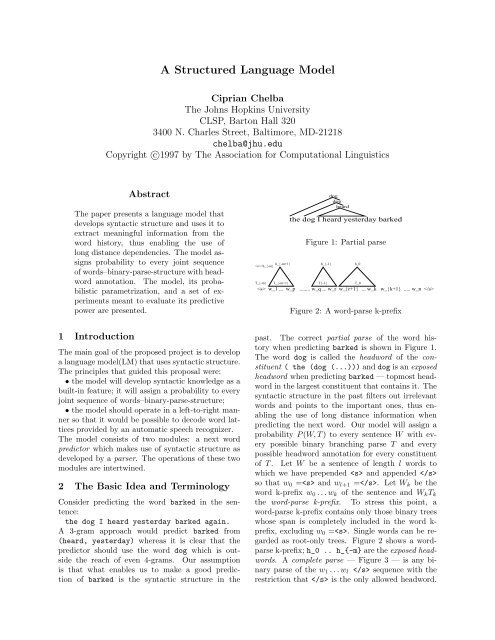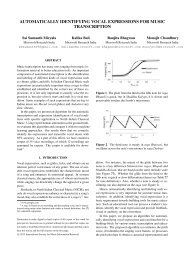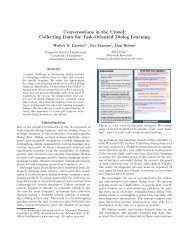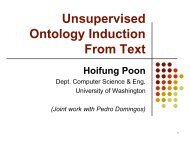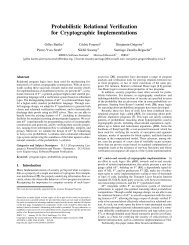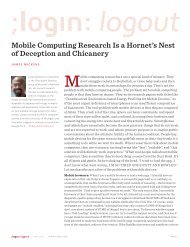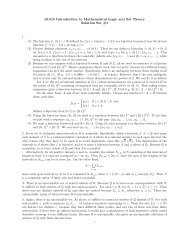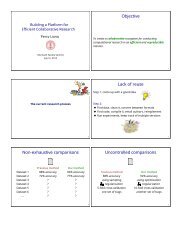PDF file - Microsoft Research
PDF file - Microsoft Research
PDF file - Microsoft Research
You also want an ePaper? Increase the reach of your titles
YUMPU automatically turns print PDFs into web optimized ePapers that Google loves.
A Structured Language Model<br />
Ciprian Chelba<br />
The Johns Hopkins University<br />
CLSP, Barton Hall 320<br />
3400 N. Charles Street, Baltimore, MD-21218<br />
chelba@jhu.edu<br />
Copyright c○1997 by The Association for Computational Linguistics<br />
Abstract<br />
The paper presents a language model that<br />
develops syntactic structure and uses it to<br />
extract meaningful information from the<br />
word history, thus enabling the use of<br />
long distance dependencies. The model assigns<br />
probability to every joint sequence<br />
of words–binary-parse-structure with headword<br />
annotation. The model, its probabilistic<br />
parametrization, and a set of experiments<br />
meant to evaluate its predictive<br />
power are presented.<br />
1 Introduction<br />
The main goal of the proposed project is to develop<br />
a language model(LM) that uses syntactic structure.<br />
The principles that guided this proposal were:<br />
• the model will develop syntactic knowledge as a<br />
built-in feature; it will assign a probability to every<br />
joint sequence of words–binary-parse-structure;<br />
• the model should operate in a left-to-right manner<br />
so that it would be possible to decode word lattices<br />
provided by an automatic speech recognizer.<br />
The model consists of two modules: a next word<br />
predictor which makes use of syntactic structure as<br />
developed by a parser. The operations of these two<br />
modules are intertwined.<br />
2 The Basic Idea and Terminology<br />
Consider predicting the word barked in the sentence:<br />
the dog I heard yesterday barked again.<br />
A 3-gram approach would predict barked from<br />
(heard, yesterday) whereas it is clear that the<br />
predictor should use the word dog which is outside<br />
the reach of even 4-grams. Our assumption<br />
is that what enables us to make a good prediction<br />
of barked is the syntactic structure in the<br />
T_{-m}<br />
dog<br />
dog<br />
heard<br />
the dog I heard yesterday barked<br />
Figure 1: Partial parse<br />
h_{-m+1} h_{-1} h_0<br />
=h_{-m}<br />
T_{-m+1}<br />
T{-1}<br />
w_1 ... w_p ........ w_q ... w_r w_{r+1} ... w_k w_{k+1} ..... w_n <br />
T_0<br />
Figure 2: A word-parse k-prefix<br />
past. The correct partial parse of the word history<br />
when predicting barked is shown in Figure 1.<br />
The word dog is called the headword of the constituent<br />
( the (dog (...))) and dog is an exposed<br />
headword when predicting barked — topmost headword<br />
in the largest constituent that contains it. The<br />
syntactic structure in the past filters out irrelevant<br />
words and points to the important ones, thus enabling<br />
the use of long distance information when<br />
predicting the next word. Our model will assign a<br />
probability P (W, T ) to every sentence W with every<br />
possible binary branching parse T and every<br />
possible headword annotation for every constituent<br />
of T . L et W be a sentence of length l words to<br />
which we have prepended and appended <br />
so that w 0 = and w l+1 =. L et W k be the<br />
word k-prefix w 0 ...w k of the sentence and W k T k<br />
the word-parse k-prefix. To stress this point, a<br />
word-parse k-prefix contains only those binary trees<br />
whose span is completely included in the word k-<br />
prefix, excluding w 0 =. Single words can be regarded<br />
as root-only trees. Figure 2 shows a wordparse<br />
k-prefix; h_0 .. h_{-m} are the exposed headwords.<br />
A complete parse — Figure 3—isanybinary<br />
parse of the w 1 ...w l sequence with the<br />
restriction that is the only allowed headword.
<br />
h_{-2}<br />
h_{-1}<br />
h_0<br />
w_1 ...... w_l <br />
T_{-m}<br />
<br />
.........<br />
T_{-2} T_{-1} T_0<br />
Figure 3: Complete parse<br />
Figure 4: Before an adjoin operation<br />
h’_{-1} = h_{-2}<br />
h’_0 = h_{-1}<br />
Note that (w 1 ...w l ) needn’t be a constituent, but<br />
for the parses where it is, there is no restriction on<br />
which of its words is the headword.<br />
The model will operate by means of two modules:<br />
• PREDICTOR predicts the next word w k+1 given<br />
the word-parse k-prefix and then passes control to<br />
the PARSER;<br />
• PARSER grows the already existing binary<br />
branching structure by repeatedly generating the<br />
transitions adjoin-left or adjoin-right until it<br />
passes control to the PREDICTOR by taking a null<br />
transition.<br />
The operations performed by the PARSER ensure<br />
that all possible binary branching parses with<br />
all possible headword assignments for the w 1 ...w k<br />
word sequence can be generated. They are illustrated<br />
by Figures 4-6. The following algorithm describes<br />
how the model generates a word sequence<br />
with a complete parse (see Figures 3-6 for notation):<br />
Transition t; // a PARSER transition<br />
generate ;<br />
do{<br />
predict next_word;<br />
//PREDICTOR<br />
do{<br />
//PARSER<br />
if(T_{-1} != )<br />
if(h_0 == ) t = adjoin-right;<br />
else t = {adjoin-{left,right}, null};<br />
else t = null;<br />
}while(t != null)<br />
}while(!(h_0 == && T_{-1} == ))<br />
t = adjoin-right; // adjoin ; DONE<br />
It is easy to see that any given word sequence with a<br />
possible parse and headword annotation is generated<br />
by a unique sequence of model actions.<br />
3 Probabilistic Model<br />
The probability P (W, T ) can be broken into:<br />
P (W, T )= ∏ l+1<br />
k=1 [P (w k/W k−1 T k−1 )·<br />
∏ Nk<br />
i=1 P (tk i /w k,W k−1 T k−1 ,t k 1 ...t k i−1 )] where:<br />
• W k−1 T k−1 is the word-parse (k − 1)-prefix<br />
• w k is the word predicted by PREDICTOR<br />
• N k − 1 is the number of adjoin operations the<br />
PARSER executes before passing control to the<br />
PREDICTOR (the N k -th operation at position k is<br />
the null transition); N k is a function of T<br />
T’_{-m+1}
The approach is similar to the trigger LM(Lau93),<br />
the difference being that in the present work triggers<br />
are identified using the syntactic structure.<br />
3.2 The second model<br />
Model (2) assigns probability to different binary<br />
parses of the word k-prefix by chaining the elementary<br />
operations described above. The workings<br />
of the PARSER are very similar to those of Spatter<br />
(Jelinek94). It can be brought to the full power<br />
of Spatter by changing the action of the adjoin<br />
operation so that it takes into account the terminal/nonterminal<br />
labels of the constituent proposed<br />
by adjoin and it also predicts the nonterminal label<br />
of the newly created constituent; PREDICTOR<br />
will now predict the next word along with its POS<br />
tag. The best equivalence classification of the W k T k<br />
word-parse k-prefix is yet to be determined. The<br />
Collins parser (Collins96) shows that dependencygrammar–like<br />
bigram constraints may be the most<br />
adequate, so the equivalence classification [W k T k ]<br />
should contain at least {h_0, h_{-1}}.<br />
4 Preliminary Experiments<br />
Assuming that the correct partial parse is a function<br />
of the word prefix, it makes sense to compare<br />
the word level perplexity(PP) of a standard n-gram<br />
LM with that of the P (w k /W k−1 T k−1 ) model. We<br />
developed and evaluated four LMs:<br />
• 2 bigram LMs P (w k /W k−1 T k−1 )=P (w k /w k−1 )<br />
referred to as W and w, respectively; w k−1 is the previous<br />
(word, POStag) pair;<br />
• 2 P (w k /W k−1 T k−1 ) = P (w k /h 0 ) models, referred<br />
to as H and h, respectively; h 0 is the previous<br />
exposed (headword, POS/non-term tag) pair; the<br />
parses used in this model were those assigned manually<br />
in the Penn Treebank (Marcus95) after undergoing<br />
headword percolation and binarization.<br />
All four LMs predict a word w k and they were<br />
implemented using the Maximum Entropy Modeling<br />
Toolkit 1 (Ristad97). The constraint templates<br />
in the {W,H} models were:<br />
4 _ ;<br />
2 ; 8 ;<br />
and in the {w,h} models they were:<br />
4 _ ;<br />
denotes a don’t care position, _ a (word,<br />
tag) pair; for example, 4 will trigger<br />
on all ((word, any tag), predicted-word) pairs<br />
that occur more than 3 times in the training data.<br />
The sentence boundary is not included in the PP calculation.<br />
Table 1 shows the PP results along with<br />
1 ftp://ftp.cs.princeton.edu/pub/packages/memt<br />
the number of parameters for each of the 4 models<br />
described .<br />
LM PP param LM PP param<br />
W 352 208487 w 419 103732<br />
H 292 206540 h 410 102437<br />
Table 1: Perplexity results<br />
5 Acknowledgements<br />
The author thanks to all the members of the Dependency<br />
Modeling Group (Chelba97):David Engle,<br />
Frederick Jelinek, Victor Jimenez, Sanjeev Khudanpur,<br />
Lidia Mangu, Harry Printz, Eric Ristad, Roni<br />
Rosenfeld, Andreas Stolcke, Dekai Wu.<br />
References<br />
Michael John Collins. 1996. A new statistical parser<br />
based on bigram lexical dependencies. In Proceedings<br />
of the 34th Annual Meeting of the Association<br />
for Computational Linguistics, 184-191,<br />
Santa Cruz, CA.<br />
Frederick Jelinek. 1997. Information extraction from<br />
speech and text — course notes. The Johns Hopkins<br />
University, Baltimore, MD.<br />
Frederick Jelinek, John Lafferty, David M. Magerman,<br />
Robert Mercer, Adwait Ratnaparkhi, Salim<br />
Roukos. 1994. Decision Tree Parsing using a Hidden<br />
Derivational Model. In Proceedings of the<br />
Human Language Technology Workshop, 272-277.<br />
ARPA.<br />
Raymond Lau, Ronald Rosenfeld, and Salim<br />
Roukos. 1993. Trigger-based language models: a<br />
maximum entropy approach. In Proceedings of the<br />
IEEE Conference on Acoustics, Speech, and Signal<br />
Processing, volume 2, 45-48, Minneapolis.<br />
Mitchell P. Marcus, Beatrice Santorini, Mary Ann<br />
Marcinkiewicz. 1995. Building a large annotated<br />
corpus of English: the Penn Treebank. Computational<br />
Linguistics, 19(2):313-330.<br />
Eric Sven Ristad. 1997. Maximum entropy modeling<br />
toolkit. Technical report, Department of Computer<br />
Science, Princeton University, Princeton,<br />
NJ, January 1997, v. 1.4 Beta.<br />
Ciprian Chelba, David Engle, Frederick Jelinek, Victor<br />
Jimenez, Sanjeev Khudanpur, Lidia Mangu,<br />
Harry Printz, Eric Sven Ristad, Roni Rosenfeld,<br />
Andreas Stolcke, Dekai Wu. 1997. Structure and<br />
Performance of a Dependency Language Model.<br />
In Proceedings of Eurospeech’97, Rhodes, Greece.<br />
To appear.


